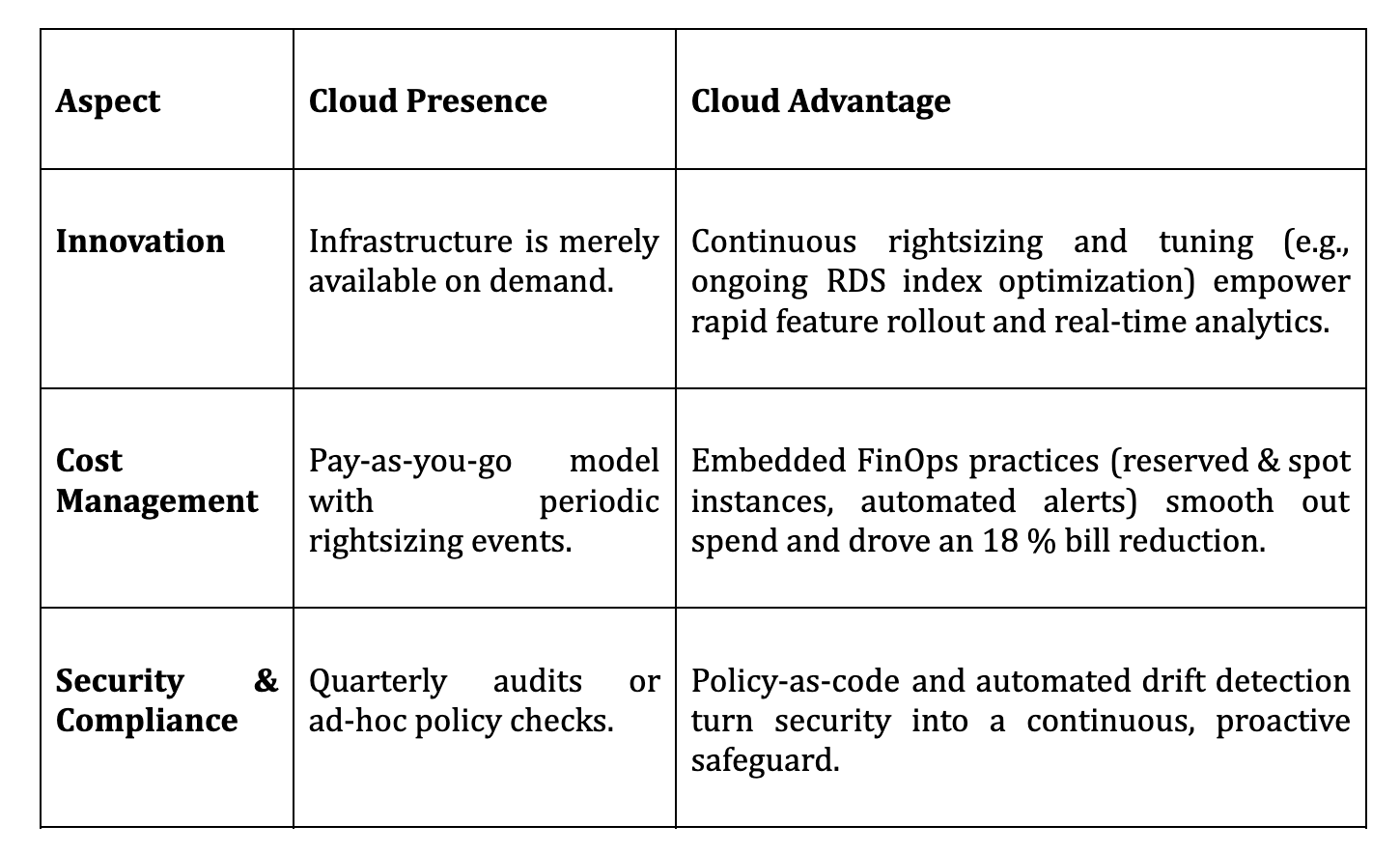Are you watching your cloud spending climb even after a successful migration? According to Gartner, fifty-one percent of enterprise IT budgets will be devoted to public cloud by 2025, yet many organisations never realise the promised returns. Cloud optimization is not a one-off checkbox, it is an ongoing discipline of right-sizing resources, enforcing cost governance, and tuning architectures to meet real business demands. In this blog, we will explore the common pitfalls of migration-only strategies and show what it truly means to embed optimization into your daily operations.
Problems with Just Migration
Simply moving applications and data to the cloud can introduce new challenges if optimization is not part of the plan:
- Overprovisioned Resources: Deploying large instances “just in case” leaves you paying for capacity you rarely use.
- Unmanaged Sprawl: Orphaned volumes, idle services, and untagged assets quietly inflate your monthly bill.
- Performance Bottlenecks: Legacy architectures shifted wholesale often underperform in a cloud environment, leading to slow response times and frustrated users.
- Lack of Governance and Visibility: Teams struggle to enforce budgets or detect anomalies without policy-as-code, automated tagging, and real-time dashboards.
These common pitfalls show why migration alone is not sufficient. The next section will define what true cloud optimization entails and how to make it a continuous practice.
What Optimization Really Means
True cloud optimization goes beyond one-time tweaks, it is a holistic, continuous approach covering four key areas:
Performance Tuning
Right-sizing compute and storage, tuning databases, and leveraging auto-scaling to match demand. For deeper guidance on database tuning, see our blog on Performance Engineering for RDS.
Cost Management
Establishing budget alerts, implementing reserved and spot-instance strategies, and regularly reviewing unused resources. Our Cloud Cost Optimization Best Practices post explores these tactics in detail.
Operational Excellence
To uncover problems before they get worse, add automated testing, continuous integration pipelines, and configuration drift detection to DevOps processes.
Governance and Security
Using policy-as-code to set up, enforce, and keep up with continuous compliance checks to stop security holes and cost leakage.
If you treat these four pillars as components of your cloud practice that can't be separated, optimization won't be an afterthought, it will be a built-in feature.
Embedding Optimization into Day-to-Day Ops
Making cloud optimization a habit requires weaving best practices into every team’s workflow:
- Architectural Patterns: Use serverless functions and container platforms to eliminate unused capacity. Split monoliths into smaller services so that each one may grow independently, which reduces wasted compute.
- DevOps Workflows: Integrate performance and cost checks into your CI/CD pipelines. For instance, every pull request should have automated load tests and cost-effect analysis to find problems before they go live.
- FinOps Discipline: Assign budget ownership to application teams and enforce charge-back models. Use automated alerts for unusual spend patterns and conduct regular cost reviews as part of sprint retrospectives.
Optimization becomes a shared responsibility rather than a one-time project by making these practices part of daily standups, code reviews, and deployment gates.
From Cloud Presence to Cloud Advantage
Simply having workloads in the cloud gives you infrastructure flexibility, but the real payoff comes when you turn that presence into an advantage:

Conclusion
Migration is just your entry ticket. The cloud's value comes from continuous optimization through performance tuning, cost control, operational excellence, and governance. Are you ready to move from being in the cloud to benefiting from it? Find out how Wissen's Optimization Framework can help you get better results and lower expenses.
FAQs
1. How do I know if my cloud environment is truly optimized instead of simply migrated?
A. When resource use matches actual demand, instances automatically scale up and down, idle services are deleted, and you get regular cost-usage statistics, and optimization happens. If your team checks performance metrics and cost warnings every day, you have gone beyond just migration.
2. What are the first signs that a migration-only strategy costs my organisation money?
A. Some common warning signs are higher than expected bills, even when workloads are stable or going down, having to resize instances often manually, and service costs that don't make sense. If you notice orphaned snapshots or resources that aren't marked in your account, those are the first things you should improve.
3. How can DevOps teams help maintain continuous cloud optimisation?
DevOps teams build performance and cost checks into CI/CD processes. For example, every pull request includes automated load tests and budget-impact analyses. This shift-left method finds problems before they get to production and makes optimization a part of every sprint.
4. What role does FinOps play in ongoing cloud tuning?
FinOps ensures budgets are followed by making application teams responsible for costs, using charge-back models, and setting up automatic alerts for strange spending. Regular cost reviews are also added as part of sprint retrospectives, making everyone on the team responsible for cloud spending.
5. Is policy-as-code really necessary for cloud optimisation?
Yes. Policy-as-code simplifies security and governance checks at provisioning time, stopping resources from starting up that aren't set up correctly or have too many permissions. Continuous compliance scans and automatic drift detection close gaps that could cause cost leaks or security holes.












